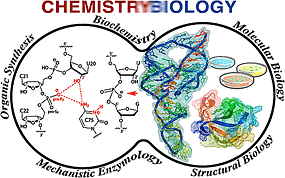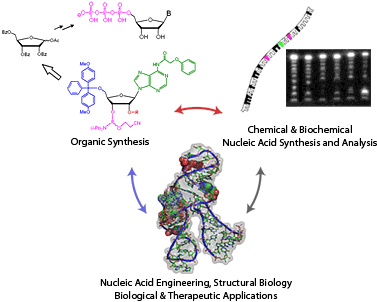RNA Chemical Biology

Chemistry provides a high resolution approach to understand biological phenomena
Biology provides the natural context to examine chemical reactivity and interaction
Life — as we know it — consists simply of self-contained nucleic acid chemistry mediated processes. Life’s information is stored in DNA, expressed through RNA and persists through the RNA and protein machinery of cellular, organic entities. The study of nucleic acids has therefore captured the imagination of generations of scientists. A half century ago the structure of DNA was elucidated, two decades ago RNA enzymes (ribozymes) were discovered, six years ago protein synthesis itself was shown to originate within ribosomal RNA and today we estimate that over thirty percent of gene function is regulated by RNA. As genomic data accumulates, we find that the complexity of organisms correlates not to the number of genes, but to the amount of non-coding DNA — all of which is transcribed into RNA.
The central theme of research in the Das laboratory is RNA Chemical Biology. We focus on seeking molecular level insights into the structure and function of nucleic acids in general and RNA in particular. Our research is currently engaged in investigating the molecular architectures of ribozymes and riboswitches — RNA motifs that bind small molecules affecting gene activity. We are also interested in the chemical and stereochemical basis of RNA-protein interactions. With modern advances in chemistry, biology and physics it is possible to analyze cellular events with atomic precision. We are a multidisciplinary laboratory that uses the tools of synthetic organic chemistry, biochemistry, mechanistic enzymology and structural and molecular biology to examine the chemical properties and reactivities that enable RNA function. We also probe functional RNA and other nucleic acid based enzymes in biological contexts seeking to discover new chemical properties and reaction pathways. These insights are applied to the design of nucleic acid catalysts and molecular switches to target specific cellular processes. Such designed nucleic acid catalysts are useful in a range of functions — from potential medicinal agents to powerful molecular tools for biology.

Selected Publications
- Das, S. R.; Piccirilli, J. A.; “General acid catalysis by the hepatitis delta virus ribozyme” Nature Chemical Biology 2005, 1, 45–52.
- Das, S. R.; Fong, R.; Piccirilli, J. A.; “Nucleotide analogues to investigate RNA structure and function” Current Opinion in Chemical Biology 2005, 9, 585–593.
- Das, S. R.; Schneller, S. W.; Balzarini, J.; De Clercq, E.; “A Mercapto Analogue of 5'-Noraristeromycin” Bioorganic & Medicinal Chemistry 2002, 10, 457–460.
- Das, S. R.; Schneller, S. W.; Balzarini, J.; De Clercq, E.; “5'-Nor Carbocyclic 5'-deoxy-5'-(isobutylthio)adenosine and a 2',3'-dideoxy-2',3'-didehydro derivative.” Antiviral Chemistry and Chemotherapy 2001, 12, 119–124.